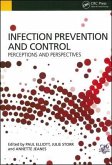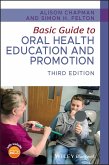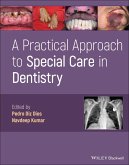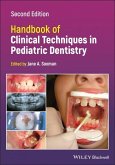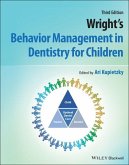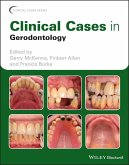Caroline L. Pankhurst, Wilson A. Coulter
Basic Guide to Infection Prevention and Control in Dentistry
Caroline L. Pankhurst, Wilson A. Coulter
Basic Guide to Infection Prevention and Control in Dentistry
- Broschiertes Buch
- Merkliste
- Auf die Merkliste
- Bewerten Bewerten
- Teilen
- Produkt teilen
- Produkterinnerung
- Produkterinnerung
A practical step-by-step guide for all members of the dental team Thoroughly updated, this new edition ensures all members of the dental team are up to speed on the practical aspects of infection prevention and control.
Andere Kunden interessierten sich auch für
![Infection Prevention and Control Infection Prevention and Control]() Infection Prevention and Control50,99 €
Infection Prevention and Control50,99 €![Basic Guide to Oral Health Education and Promotion Basic Guide to Oral Health Education and Promotion]() Alison Chapman (UK Bristol Dental Hospital)Basic Guide to Oral Health Education and Promotion60,99 €
Alison Chapman (UK Bristol Dental Hospital)Basic Guide to Oral Health Education and Promotion60,99 €![A Practical Approach to Special Care in Dentistry A Practical Approach to Special Care in Dentistry]() A Practical Approach to Special Care in Dentistry113,99 €
A Practical Approach to Special Care in Dentistry113,99 €![Handbook of Clinical Techniques in Pediatric Dentistry Handbook of Clinical Techniques in Pediatric Dentistry]() Handbook of Clinical Techniques in Pediatric Dentistry113,99 €
Handbook of Clinical Techniques in Pediatric Dentistry113,99 €![Wright's Behavior Management in Dentistry for Children Wright's Behavior Management in Dentistry for Children]() Wright's Behavior Management in Dentistry for Children156,99 €
Wright's Behavior Management in Dentistry for Children156,99 €![Clinical Cases in Gerodontology Clinical Cases in Gerodontology]() Clinical Cases in Gerodontology85,99 €
Clinical Cases in Gerodontology85,99 €![Infection Prevention and Control Infection Prevention and Control]() Infection Prevention and Control136,99 €
Infection Prevention and Control136,99 €-
-
-
A practical step-by-step guide for all members of the dental team Thoroughly updated, this new edition ensures all members of the dental team are up to speed on the practical aspects of infection prevention and control.
Hinweis: Dieser Artikel kann nur an eine deutsche Lieferadresse ausgeliefert werden.
Hinweis: Dieser Artikel kann nur an eine deutsche Lieferadresse ausgeliefert werden.
Produktdetails
- Produktdetails
- Basic Guide Dentistry Series
- Verlag: John Wiley & Sons Inc
- 2nd Edition
- Seitenzahl: 240
- Erscheinungstermin: 17. April 2017
- Englisch
- Abmessung: 229mm x 150mm x 13mm
- Gewicht: 398g
- ISBN-13: 9781119164982
- ISBN-10: 1119164982
- Artikelnr.: 47710958
- Herstellerkennzeichnung
- Libri GmbH
- Europaallee 1
- 36244 Bad Hersfeld
- gpsr@libri.de
- Basic Guide Dentistry Series
- Verlag: John Wiley & Sons Inc
- 2nd Edition
- Seitenzahl: 240
- Erscheinungstermin: 17. April 2017
- Englisch
- Abmessung: 229mm x 150mm x 13mm
- Gewicht: 398g
- ISBN-13: 9781119164982
- ISBN-10: 1119164982
- Artikelnr.: 47710958
- Herstellerkennzeichnung
- Libri GmbH
- Europaallee 1
- 36244 Bad Hersfeld
- gpsr@libri.de
About the Authors Dr Caroline L. Pankhurst BSc, BDS, MSc, PhD, MRCPath, is a former Clinical Senior Lecturer in Oral Microbiology at the Dental Institute of King's College London and a Specialist in Oral Microbiology. Professor Wilson A. Coulter BSc, BDS, PGCert Ed, MSc, PhD, FRCPath, is a Professor of Oral Microbiology at the University of Ulster and former Consultant/Reader in Oral Microbiology at the School of Medicine and Dentistry, Queen's University Belfast. The authors are dentally qualified medical microbiologists with extensive experience in the field of infection control in dentistry. They have published numerous scientific studies in the field, the findings of which have been presented at conferences around the world. Both authors have served on government advisory bodies on infection control and decontamination, and teach dentists, nurses, therapists and hygienists at both pre- and post-qualification level in the UK and overseas.
Foreword viii Preface ix Acknowledgements x About the companion website xi 1 Essentials of infection control 1 Why do we need infection control in dentistry? 1 Relative risk and risk perception 2 Risk assessment and the management decision
making process 3 How to perform a risk assessment in a dental practice 4 Hierarchy of risk management control 6 Infection control and the law 7 Legal acts under which dental practice is conducted 8 Published standards and guidance 12 Team approach to prevention of infection 13 2 Communicable diseases in the dental surgery 16 How infections are spread 16 Reservoirs and sources of infection 18 Infectious diseases by route of infection in dentistry 19 Infectious disease by route of transmission in the dental surgery 20 Emerging and re
emerging pathogens 28 3 Occupational health and immunization 34 Occupational health hazards 34 Building a culture of safety 35 Organizing staff health in a dental practice 37 Immunization requirements for dentistry 39 Protecting women of childbearing age 39 Occupational vaccines to protect against hepatitis and TB 43 Health checks and the consequences of blood
borne virus infection 46 Health clearance 47 Duty of care to patients 50 4 Sharp safe working in the dental surgery 53 Why sharps prevention is important 53 When do sharps injuries occur? 55 Preventable sharps injuries 56 How to avoid a sharps injury 56 Managing sharps injuries and splashes 60 Occupational health risk assessment for BBV exposure 62 Management of hepatitis C exposures 62 Postexposure prophylaxis for HIV and hepatitis B 64 Recording of sharps injuries 66 Clinical governance and accident risk assessment 66 5 Hand hygiene 68 Hands as a source of infection 68 Hands as a source of hospital
acquired infection 69 Hand hygiene and teamworking 70 Hand hygiene technique 76 Hand care and prevention of dermatitis 82 6 Personal protection for prevention of cross
infection 85 Why we wear personal protective equipment 85 The role of gloves 86 Choosing a suitable glove for the task 88 Managing an allergy to NRL gloves 88 Managing latex allergies in patients 90 Masks and when to use them 91 Protective eyewear and visors 95 Protection during cardiopulmonary resuscitation 97 Tunics and uniforms 99 Protective barriers - plastic aprons and surgical gowns 102 7 Sterilization and disinfection of dental instruments 105 Decontamination cycle 105 Why has cleaning become so important? 106 Legal requirements and technical standards for decontamination 107 Where should instrument decontamination take place? 110 Design of dedicated decontamination units 110 Purchasing of dental equipment 117 Cleaning of dental instruments 118 Disinfection of dental handpieces 121 Mechanical cleaning with an ultrasonic bath 124 Thermal washer disinfectors 126 Instrument inspection 130 Dental instrument sterilization 130 Suitability of sterilizer for different loads 130 Sterilizer installation and validation 131 Steam purity and maintenance of water reservoir chamber 132 How do you know your sterilizer is working? 133 Loading the sterilizer 138 Storage of wrapped and unwrapped instruments 138 Single
use items 142 Variant CJD and rationale for single
use items 144 Disinfection of heat
sensitive equipment and hard surfaces 144 Disinfection of dental impressions 146 8 Dental surgery design, surface decontamination and managing aerosols 148 Dental surgery design 148 Survival of microbes on surgery surfaces 153 General cleaning 154 Surface decontamination in the dental surgery 156 Management of aerosols and splatter 162 Managing large blood or body fluid spillages 164 9 Management of dental unit waterlines 167 What are biofilms? 167 Risk to staff and patient health from dental unit waterlines 168 Methods to reduce the biofilm 173 Control of legionellae in the dental practice water supply 180 10 Healthcare waste management 182 Legislation on hazardous waste disposal 182 Types of waste 184 What is hazardous waste? 185 Clinical waste segregation and classification 189 Amalgam waste and installation of amalgam separators 193 Mercury in the environment 193 Disposal and handling of hazardous waste in the surgery 195 Safe handling of clinical waste prior to disposal 197 Bulk storage of waste for collection 197 Transport of hazardous waste 198 Benefits of waste segregation 198 11 Transport and postage of diagnostic specimens, impressions and equipment for servicing and repair 201 Legal framework 201 Collecting specimens 202 Transport of specimens to the laboratory 203 Transport restrictions 204 Fixed pathological specimens 205 Transporting impressions 206 Equipment to be sent for service or repair 206 Appendix 208 Table A.1 Daily infection control clinical pathway 208 Table A.2 Decontamination methods for specific instruments and items of dental equipment 211 Table A.3 Examples of hand and hard surface disinfectants and dental unit waterline biocides 214 Index 217
making process 3 How to perform a risk assessment in a dental practice 4 Hierarchy of risk management control 6 Infection control and the law 7 Legal acts under which dental practice is conducted 8 Published standards and guidance 12 Team approach to prevention of infection 13 2 Communicable diseases in the dental surgery 16 How infections are spread 16 Reservoirs and sources of infection 18 Infectious diseases by route of infection in dentistry 19 Infectious disease by route of transmission in the dental surgery 20 Emerging and re
emerging pathogens 28 3 Occupational health and immunization 34 Occupational health hazards 34 Building a culture of safety 35 Organizing staff health in a dental practice 37 Immunization requirements for dentistry 39 Protecting women of childbearing age 39 Occupational vaccines to protect against hepatitis and TB 43 Health checks and the consequences of blood
borne virus infection 46 Health clearance 47 Duty of care to patients 50 4 Sharp safe working in the dental surgery 53 Why sharps prevention is important 53 When do sharps injuries occur? 55 Preventable sharps injuries 56 How to avoid a sharps injury 56 Managing sharps injuries and splashes 60 Occupational health risk assessment for BBV exposure 62 Management of hepatitis C exposures 62 Postexposure prophylaxis for HIV and hepatitis B 64 Recording of sharps injuries 66 Clinical governance and accident risk assessment 66 5 Hand hygiene 68 Hands as a source of infection 68 Hands as a source of hospital
acquired infection 69 Hand hygiene and teamworking 70 Hand hygiene technique 76 Hand care and prevention of dermatitis 82 6 Personal protection for prevention of cross
infection 85 Why we wear personal protective equipment 85 The role of gloves 86 Choosing a suitable glove for the task 88 Managing an allergy to NRL gloves 88 Managing latex allergies in patients 90 Masks and when to use them 91 Protective eyewear and visors 95 Protection during cardiopulmonary resuscitation 97 Tunics and uniforms 99 Protective barriers - plastic aprons and surgical gowns 102 7 Sterilization and disinfection of dental instruments 105 Decontamination cycle 105 Why has cleaning become so important? 106 Legal requirements and technical standards for decontamination 107 Where should instrument decontamination take place? 110 Design of dedicated decontamination units 110 Purchasing of dental equipment 117 Cleaning of dental instruments 118 Disinfection of dental handpieces 121 Mechanical cleaning with an ultrasonic bath 124 Thermal washer disinfectors 126 Instrument inspection 130 Dental instrument sterilization 130 Suitability of sterilizer for different loads 130 Sterilizer installation and validation 131 Steam purity and maintenance of water reservoir chamber 132 How do you know your sterilizer is working? 133 Loading the sterilizer 138 Storage of wrapped and unwrapped instruments 138 Single
use items 142 Variant CJD and rationale for single
use items 144 Disinfection of heat
sensitive equipment and hard surfaces 144 Disinfection of dental impressions 146 8 Dental surgery design, surface decontamination and managing aerosols 148 Dental surgery design 148 Survival of microbes on surgery surfaces 153 General cleaning 154 Surface decontamination in the dental surgery 156 Management of aerosols and splatter 162 Managing large blood or body fluid spillages 164 9 Management of dental unit waterlines 167 What are biofilms? 167 Risk to staff and patient health from dental unit waterlines 168 Methods to reduce the biofilm 173 Control of legionellae in the dental practice water supply 180 10 Healthcare waste management 182 Legislation on hazardous waste disposal 182 Types of waste 184 What is hazardous waste? 185 Clinical waste segregation and classification 189 Amalgam waste and installation of amalgam separators 193 Mercury in the environment 193 Disposal and handling of hazardous waste in the surgery 195 Safe handling of clinical waste prior to disposal 197 Bulk storage of waste for collection 197 Transport of hazardous waste 198 Benefits of waste segregation 198 11 Transport and postage of diagnostic specimens, impressions and equipment for servicing and repair 201 Legal framework 201 Collecting specimens 202 Transport of specimens to the laboratory 203 Transport restrictions 204 Fixed pathological specimens 205 Transporting impressions 206 Equipment to be sent for service or repair 206 Appendix 208 Table A.1 Daily infection control clinical pathway 208 Table A.2 Decontamination methods for specific instruments and items of dental equipment 211 Table A.3 Examples of hand and hard surface disinfectants and dental unit waterline biocides 214 Index 217
Foreword viii Preface ix Acknowledgements x About the companion website xi 1 Essentials of infection control 1 Why do we need infection control in dentistry? 1 Relative risk and risk perception 2 Risk assessment and the management decision
making process 3 How to perform a risk assessment in a dental practice 4 Hierarchy of risk management control 6 Infection control and the law 7 Legal acts under which dental practice is conducted 8 Published standards and guidance 12 Team approach to prevention of infection 13 2 Communicable diseases in the dental surgery 16 How infections are spread 16 Reservoirs and sources of infection 18 Infectious diseases by route of infection in dentistry 19 Infectious disease by route of transmission in the dental surgery 20 Emerging and re
emerging pathogens 28 3 Occupational health and immunization 34 Occupational health hazards 34 Building a culture of safety 35 Organizing staff health in a dental practice 37 Immunization requirements for dentistry 39 Protecting women of childbearing age 39 Occupational vaccines to protect against hepatitis and TB 43 Health checks and the consequences of blood
borne virus infection 46 Health clearance 47 Duty of care to patients 50 4 Sharp safe working in the dental surgery 53 Why sharps prevention is important 53 When do sharps injuries occur? 55 Preventable sharps injuries 56 How to avoid a sharps injury 56 Managing sharps injuries and splashes 60 Occupational health risk assessment for BBV exposure 62 Management of hepatitis C exposures 62 Postexposure prophylaxis for HIV and hepatitis B 64 Recording of sharps injuries 66 Clinical governance and accident risk assessment 66 5 Hand hygiene 68 Hands as a source of infection 68 Hands as a source of hospital
acquired infection 69 Hand hygiene and teamworking 70 Hand hygiene technique 76 Hand care and prevention of dermatitis 82 6 Personal protection for prevention of cross
infection 85 Why we wear personal protective equipment 85 The role of gloves 86 Choosing a suitable glove for the task 88 Managing an allergy to NRL gloves 88 Managing latex allergies in patients 90 Masks and when to use them 91 Protective eyewear and visors 95 Protection during cardiopulmonary resuscitation 97 Tunics and uniforms 99 Protective barriers - plastic aprons and surgical gowns 102 7 Sterilization and disinfection of dental instruments 105 Decontamination cycle 105 Why has cleaning become so important? 106 Legal requirements and technical standards for decontamination 107 Where should instrument decontamination take place? 110 Design of dedicated decontamination units 110 Purchasing of dental equipment 117 Cleaning of dental instruments 118 Disinfection of dental handpieces 121 Mechanical cleaning with an ultrasonic bath 124 Thermal washer disinfectors 126 Instrument inspection 130 Dental instrument sterilization 130 Suitability of sterilizer for different loads 130 Sterilizer installation and validation 131 Steam purity and maintenance of water reservoir chamber 132 How do you know your sterilizer is working? 133 Loading the sterilizer 138 Storage of wrapped and unwrapped instruments 138 Single
use items 142 Variant CJD and rationale for single
use items 144 Disinfection of heat
sensitive equipment and hard surfaces 144 Disinfection of dental impressions 146 8 Dental surgery design, surface decontamination and managing aerosols 148 Dental surgery design 148 Survival of microbes on surgery surfaces 153 General cleaning 154 Surface decontamination in the dental surgery 156 Management of aerosols and splatter 162 Managing large blood or body fluid spillages 164 9 Management of dental unit waterlines 167 What are biofilms? 167 Risk to staff and patient health from dental unit waterlines 168 Methods to reduce the biofilm 173 Control of legionellae in the dental practice water supply 180 10 Healthcare waste management 182 Legislation on hazardous waste disposal 182 Types of waste 184 What is hazardous waste? 185 Clinical waste segregation and classification 189 Amalgam waste and installation of amalgam separators 193 Mercury in the environment 193 Disposal and handling of hazardous waste in the surgery 195 Safe handling of clinical waste prior to disposal 197 Bulk storage of waste for collection 197 Transport of hazardous waste 198 Benefits of waste segregation 198 11 Transport and postage of diagnostic specimens, impressions and equipment for servicing and repair 201 Legal framework 201 Collecting specimens 202 Transport of specimens to the laboratory 203 Transport restrictions 204 Fixed pathological specimens 205 Transporting impressions 206 Equipment to be sent for service or repair 206 Appendix 208 Table A.1 Daily infection control clinical pathway 208 Table A.2 Decontamination methods for specific instruments and items of dental equipment 211 Table A.3 Examples of hand and hard surface disinfectants and dental unit waterline biocides 214 Index 217
making process 3 How to perform a risk assessment in a dental practice 4 Hierarchy of risk management control 6 Infection control and the law 7 Legal acts under which dental practice is conducted 8 Published standards and guidance 12 Team approach to prevention of infection 13 2 Communicable diseases in the dental surgery 16 How infections are spread 16 Reservoirs and sources of infection 18 Infectious diseases by route of infection in dentistry 19 Infectious disease by route of transmission in the dental surgery 20 Emerging and re
emerging pathogens 28 3 Occupational health and immunization 34 Occupational health hazards 34 Building a culture of safety 35 Organizing staff health in a dental practice 37 Immunization requirements for dentistry 39 Protecting women of childbearing age 39 Occupational vaccines to protect against hepatitis and TB 43 Health checks and the consequences of blood
borne virus infection 46 Health clearance 47 Duty of care to patients 50 4 Sharp safe working in the dental surgery 53 Why sharps prevention is important 53 When do sharps injuries occur? 55 Preventable sharps injuries 56 How to avoid a sharps injury 56 Managing sharps injuries and splashes 60 Occupational health risk assessment for BBV exposure 62 Management of hepatitis C exposures 62 Postexposure prophylaxis for HIV and hepatitis B 64 Recording of sharps injuries 66 Clinical governance and accident risk assessment 66 5 Hand hygiene 68 Hands as a source of infection 68 Hands as a source of hospital
acquired infection 69 Hand hygiene and teamworking 70 Hand hygiene technique 76 Hand care and prevention of dermatitis 82 6 Personal protection for prevention of cross
infection 85 Why we wear personal protective equipment 85 The role of gloves 86 Choosing a suitable glove for the task 88 Managing an allergy to NRL gloves 88 Managing latex allergies in patients 90 Masks and when to use them 91 Protective eyewear and visors 95 Protection during cardiopulmonary resuscitation 97 Tunics and uniforms 99 Protective barriers - plastic aprons and surgical gowns 102 7 Sterilization and disinfection of dental instruments 105 Decontamination cycle 105 Why has cleaning become so important? 106 Legal requirements and technical standards for decontamination 107 Where should instrument decontamination take place? 110 Design of dedicated decontamination units 110 Purchasing of dental equipment 117 Cleaning of dental instruments 118 Disinfection of dental handpieces 121 Mechanical cleaning with an ultrasonic bath 124 Thermal washer disinfectors 126 Instrument inspection 130 Dental instrument sterilization 130 Suitability of sterilizer for different loads 130 Sterilizer installation and validation 131 Steam purity and maintenance of water reservoir chamber 132 How do you know your sterilizer is working? 133 Loading the sterilizer 138 Storage of wrapped and unwrapped instruments 138 Single
use items 142 Variant CJD and rationale for single
use items 144 Disinfection of heat
sensitive equipment and hard surfaces 144 Disinfection of dental impressions 146 8 Dental surgery design, surface decontamination and managing aerosols 148 Dental surgery design 148 Survival of microbes on surgery surfaces 153 General cleaning 154 Surface decontamination in the dental surgery 156 Management of aerosols and splatter 162 Managing large blood or body fluid spillages 164 9 Management of dental unit waterlines 167 What are biofilms? 167 Risk to staff and patient health from dental unit waterlines 168 Methods to reduce the biofilm 173 Control of legionellae in the dental practice water supply 180 10 Healthcare waste management 182 Legislation on hazardous waste disposal 182 Types of waste 184 What is hazardous waste? 185 Clinical waste segregation and classification 189 Amalgam waste and installation of amalgam separators 193 Mercury in the environment 193 Disposal and handling of hazardous waste in the surgery 195 Safe handling of clinical waste prior to disposal 197 Bulk storage of waste for collection 197 Transport of hazardous waste 198 Benefits of waste segregation 198 11 Transport and postage of diagnostic specimens, impressions and equipment for servicing and repair 201 Legal framework 201 Collecting specimens 202 Transport of specimens to the laboratory 203 Transport restrictions 204 Fixed pathological specimens 205 Transporting impressions 206 Equipment to be sent for service or repair 206 Appendix 208 Table A.1 Daily infection control clinical pathway 208 Table A.2 Decontamination methods for specific instruments and items of dental equipment 211 Table A.3 Examples of hand and hard surface disinfectants and dental unit waterline biocides 214 Index 217


